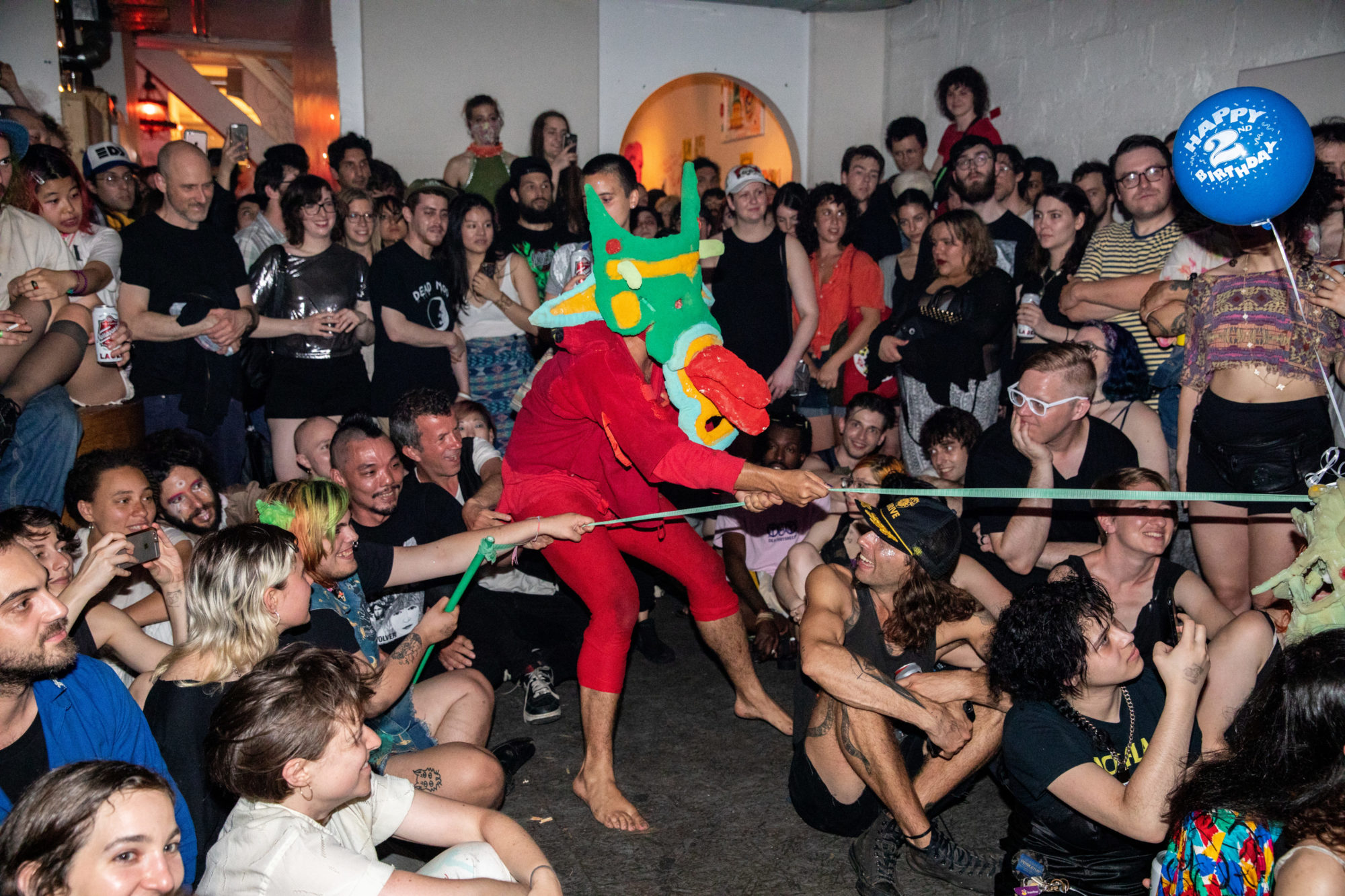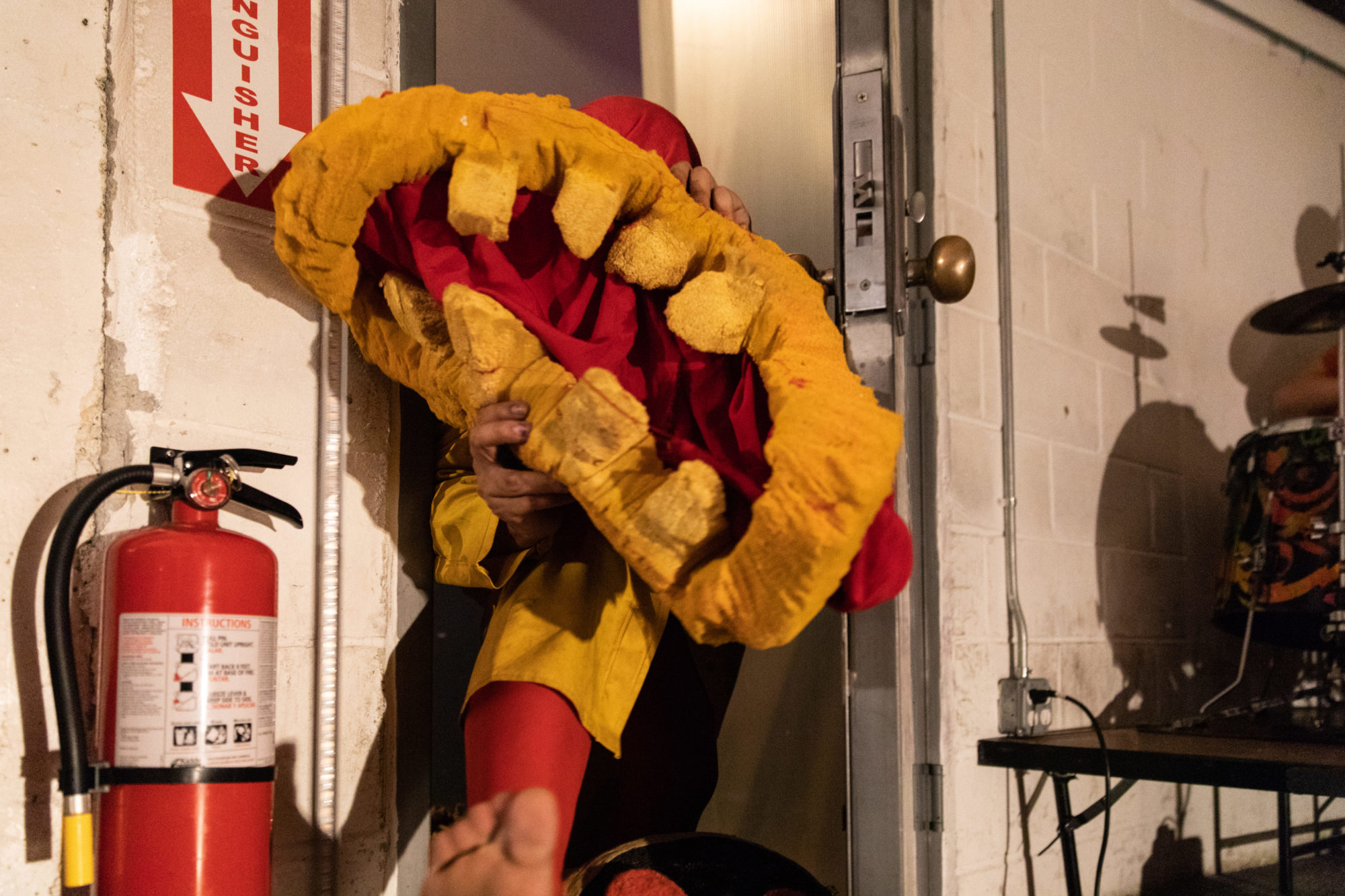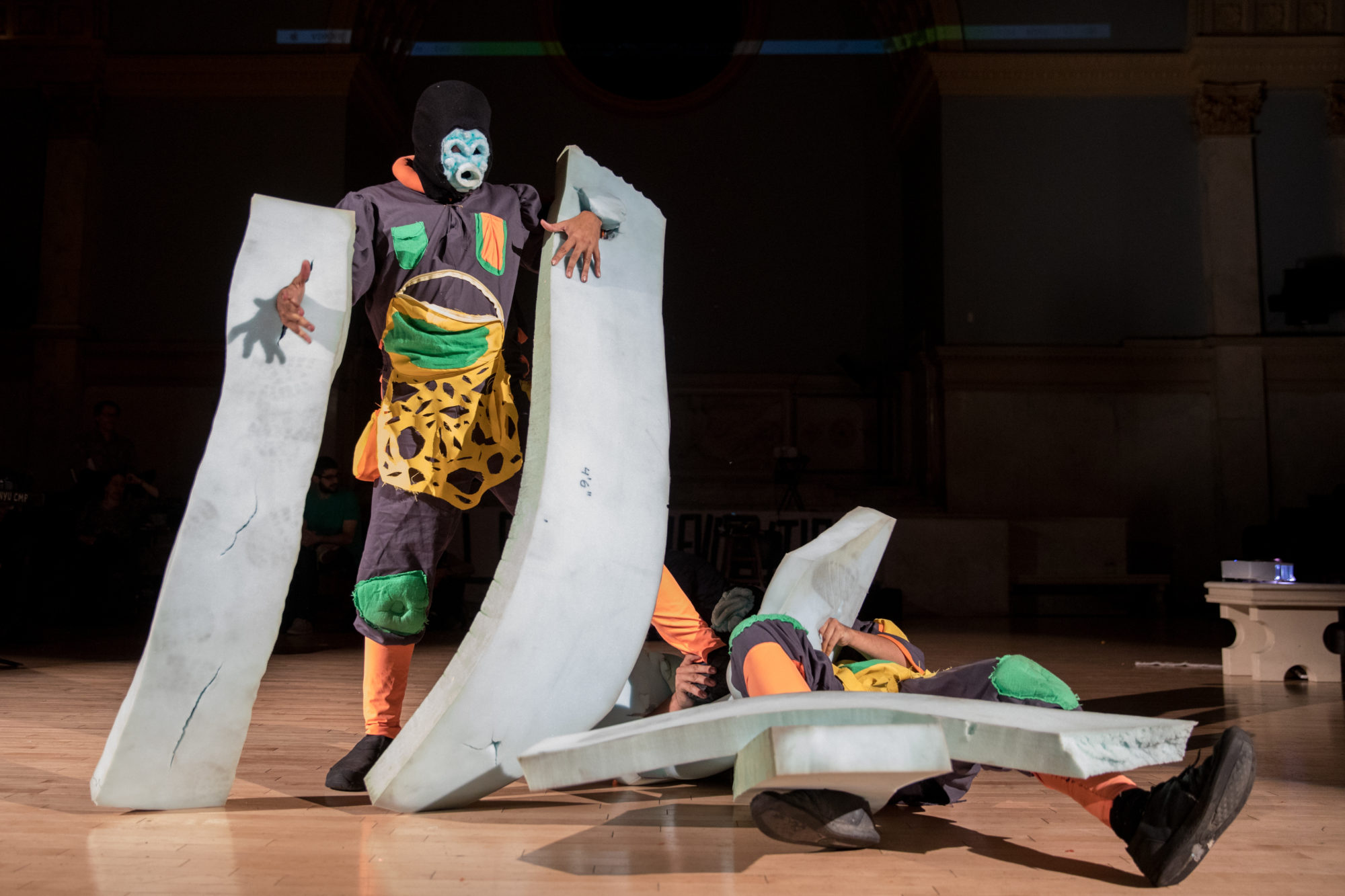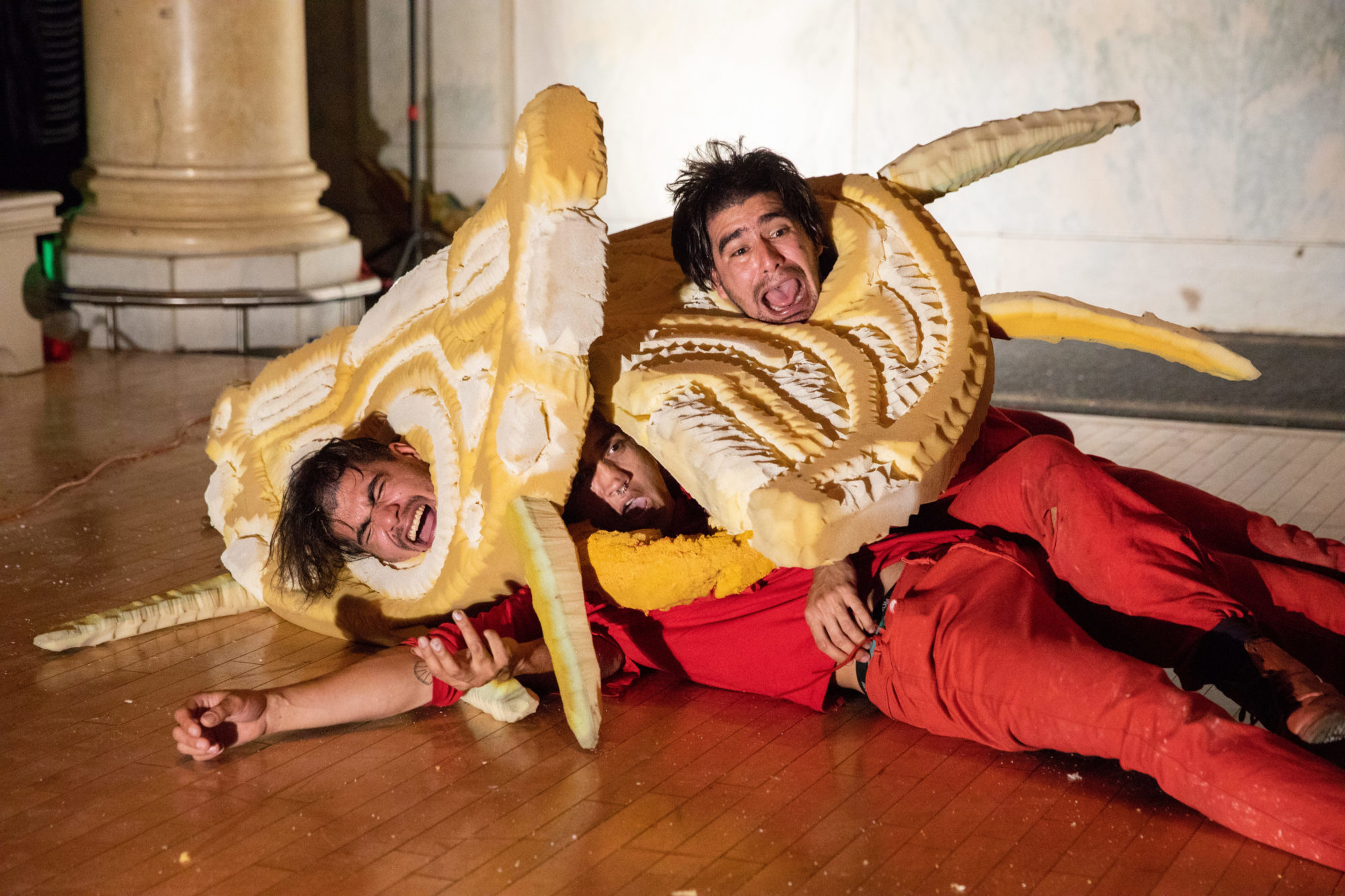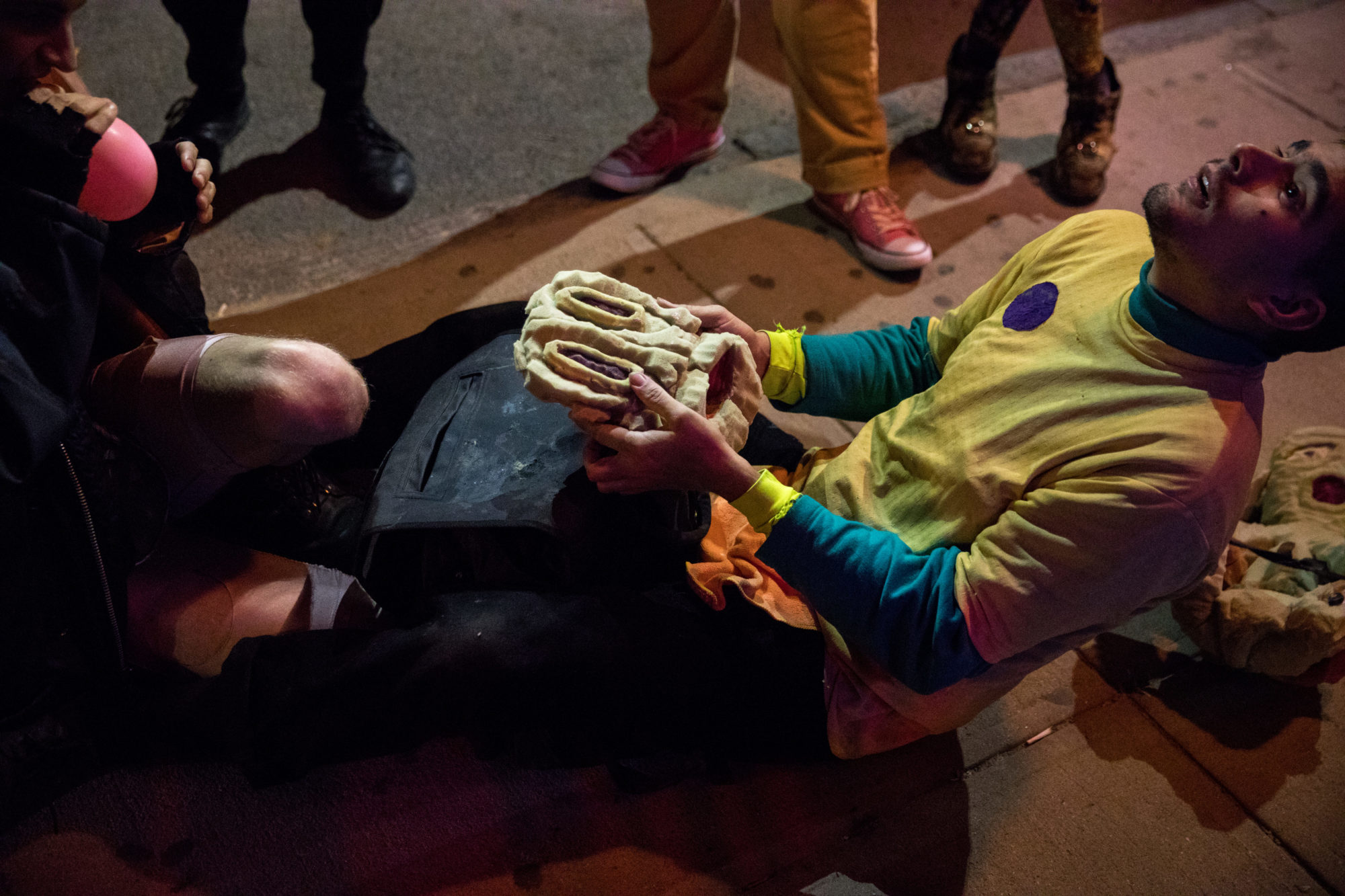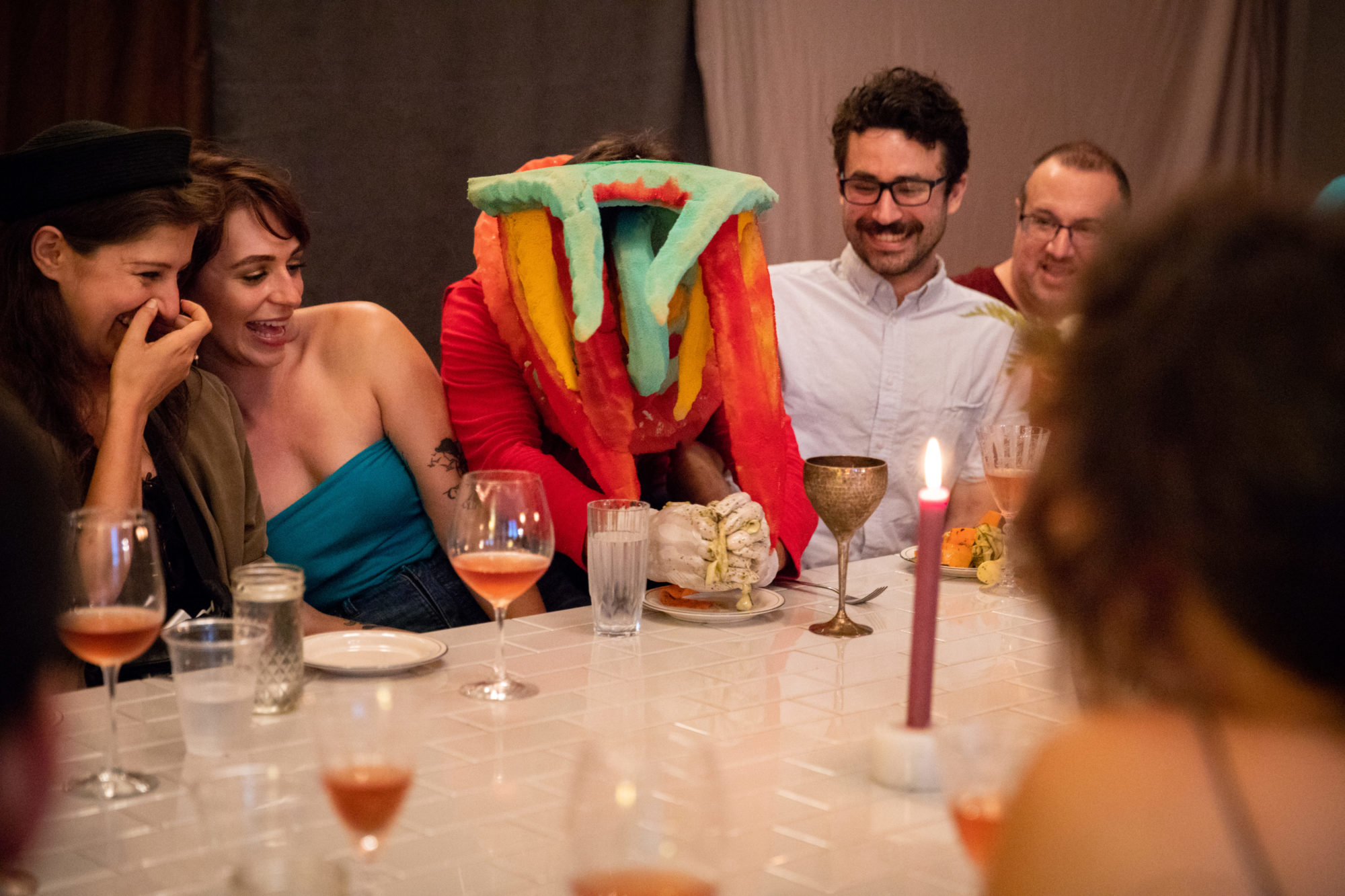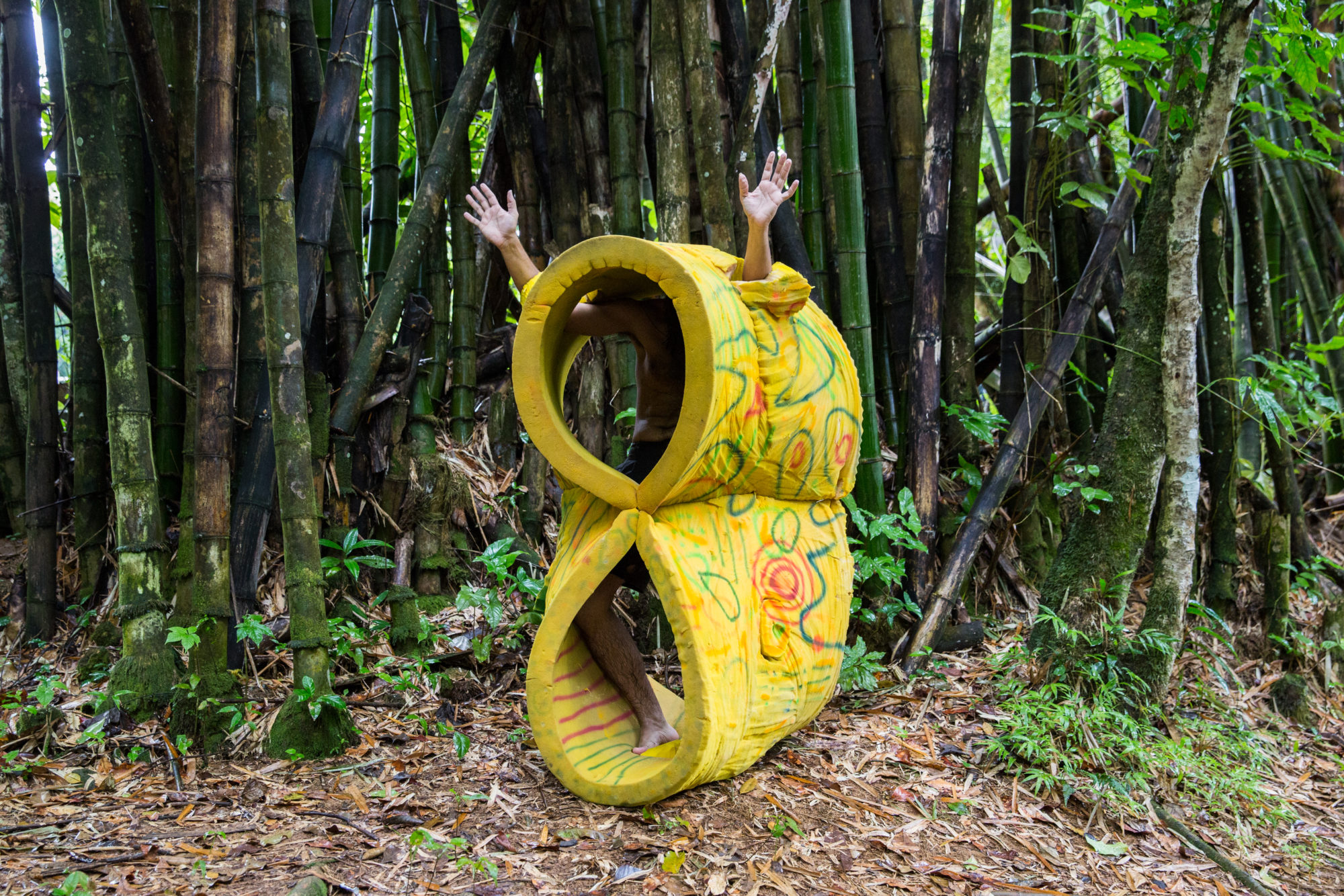Poncili Creación Fights a More Beautiful Fight
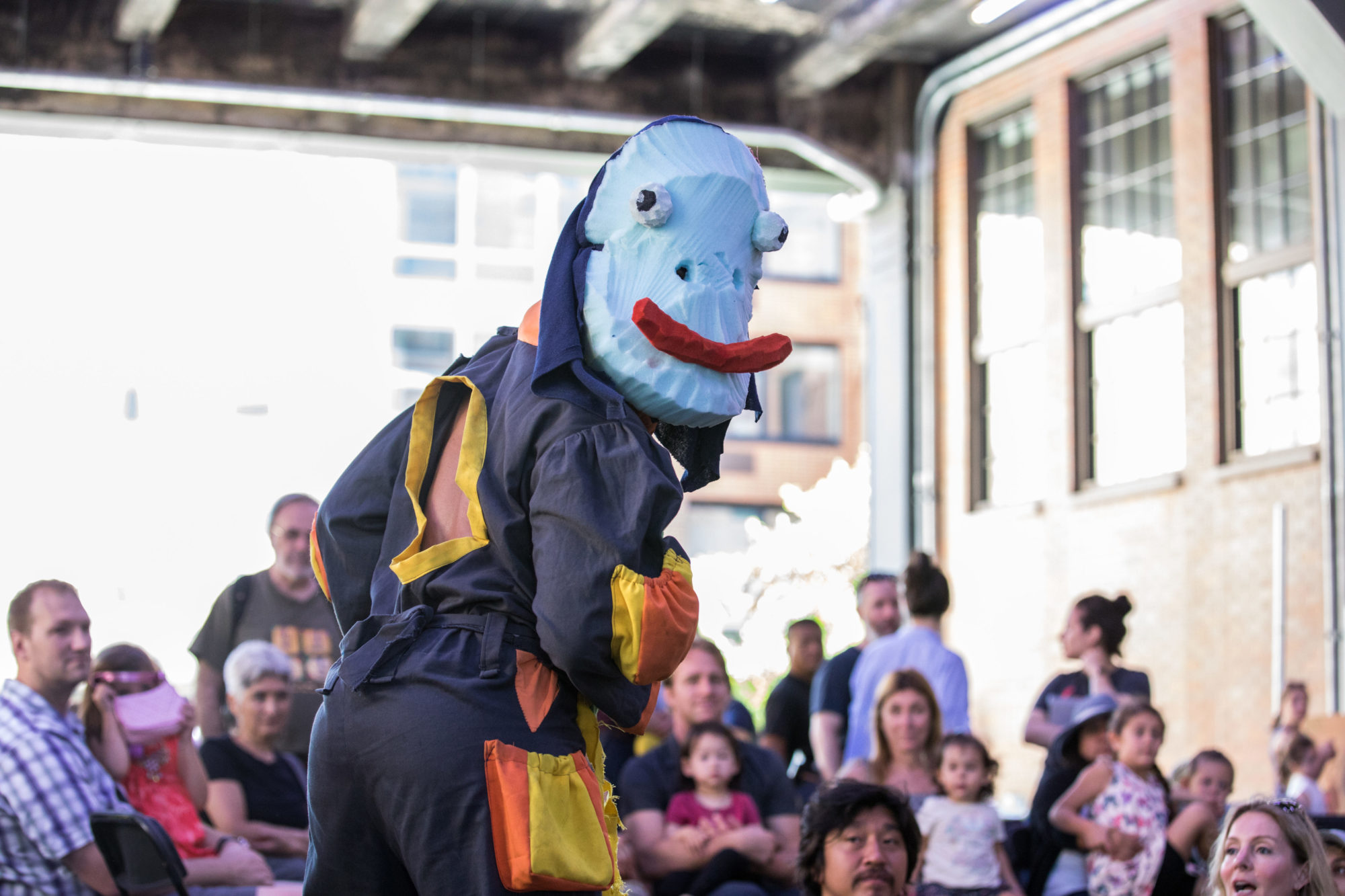
Share:
In a soft voice, a barefoot young man asks those gathered to please create an aisle down the center of the room. He is dressed only in red, with a nylon stocking over his face and something like a packing peanut wedged between the stocking and his nose. He assures us that no one will be hurt. He does not seem particularly intent on keeping that promise a few minutes later, running headlong into his brother at the back of the room, breaking their fall on several people who seem glad to have been helpful.
For the rest of the evening, the performers spend as much time in the air as on the floor. They expend as much energy on slapstick as on sleight-of-hand. With the aid of elegantly constructed foam objects, they coax and cudgel each other into various feats, taking turns as the matador and the bull, the cobra and the charmer. A mouth regurgitates the man who once ate with it. A dress swallows whole its wearer. Green masks of the dragon/mantis variety are doffed, begin to prance around on legs that were previously antennae. Wailing, these creatures are passed to the audience in a mass adoption ceremony.
The newly created parents are wordlessly petitioned to aid in every step of the performance. We take up sides in a grand tug-of-war. We consent to be kissed by a pair of oversized pop-out eyes dragging six feet of optical nerve behind them. Yelling wordlessly on command, our voices find a resonant frequency in the room, which seems to vibrate. As it does, a plush, basketball-sized pearl is produced from beneath a shirt, sheds its first skin, and becomes a globe, the zipper at its back having been operated by the performer’s teeth. The participation of the audience in this spectacular is never coerced. Each whoop, each gasp, seems the product of honest amazement.
The group is Poncili Creación, consisting primarily of identical twin brothers Efrain and Pablo Del Hierro, but including as many collaborators as needed moment-to-moment. In this case, three musicians in guitar-bass-drums formation are outfitted with the group’s signature foam neck ruffs and contribute squeals and squawks to the atmosphere. A third performer, Alex Millán (aka Arcoíris.tropical) aids in the physical action. The venue is The Glove, an improbable show space in Brooklyn that manages to incorporate a gallery, a guitar shop, a hair salon, a rooftop garden, a dungeon-themed lounge, and an “ask-a-punk” code of semi secrecy. Poncili is the final act on a bill including three others, which have been primarily musical.
Apart from the advisory at the beginning and some acknowledgments at the end, the only words audible during the performance are “Someone else will take care of that,” in reference to a prop that has skittered away. Even without speaking, the show seems to excitedly talk over itself, its three performers taking up and discarding a great number of characters in just 20 minutes. The evening ends in a heap of bodies and objects, and to enthusiastic applause.
When I speak with Efrain and Pablo, they are at home in San Juan, Puerto Rico, having just concluded their latest tour of the eastern United States. Since 2012 they have taken their show on the road in North America and, more recently, Europe. They now estimate they spend half the year performing elsewhere. The previous two months included dates in Miami, New Orleans, Savannah, Baltimore, and other cities along the US Atlantic Seaboard. They took up residence for days or weeks at a time, performed as much as possible, and slept on floors, in cars, and among friends.
Often traveling with nothing other than their personal effects and “a bunch of fabric in a bag,” they scrounge material on the streets and formulate their show from what they find. They work primarily in polyurethane foam, which they credit for giving the objects their distinctive qualities: a quivering, reactive motion; the ability to compress and expand; ease of manipulation and of transport. Most importantly, this material is handily found in whatever city they are visiting, typically in the form of curbside furniture and mattresses.
“We usually do this at 2 am, in a car,” explains Efrain, “me and Pablo, with knives and scissors.” They have on occasion dramatized the process for a live audience, performing what they refer to as “couch murderings.” In these rituals, a sofa is recovered from the street and placed center stage. Efrain and Pablo emerge naked, with knives, stalking their prey. When the moment is right, they pounce, tearing off its skin and fashioning clothes for themselves. With the meaty foam, they craft new objects right there on stage.
“These things have a massive history,” Efrain says. “Sex, sleeping, hanging out ….”
“They’re like temples of the house,” continues Pablo. “Both the sofa and the bed are these ballistic places, so they have that object-memory.” He goes on to describe a hypothetical scenario in which a romantic sculptor feels he must sleep on his block of wood for a week so he can carve from it the dreams that will have accumulated there. “But this has the allure,” Pablo concludes of their chosen material, “that we don’t know who the hell had it.”
Under Poncili’s care, the foam takes on a different character, one less suggestive of repose. A mattress pad becomes a roiling sea. The seat of an armchair becomes a school of eels. Some of their creations are obviously puppets. Others are too outlandish to be obviously anything. “We say objects,” says Pablo.
“Apart from objects, we call it equipment,” Efrain adds.
Pablo grins. “These are the tools of our trade, our bow and arrow.”
When their equipment appears in galleries, as it increasingly does, it is sculpture, but “incomplete sculpture, because the movement completes it,” as Efrain explains. “So you’re seeing something that has some properties that are not on display …. It’s important to point out that this has a use, and that it’s not being on a wall.”
The two are frank about the economic rationale for opting in to establishment cultural circles, in addition to more underground venues. “It has been very beneficial for us to start subtly showing face in the art world,” Pablo says. “There’s a lot of money in the art world that we are definitely not seeing anywhere else, and that gives us a little bit of relief …. Each time we make a good-paying gig, we can do from 10 to 30 free shows.”
As for those shows, Pablo and Efrain have taken to calling them sets, on the model of the noise music scene in Miami that first took them in. (“They thought we were a noise band, you know?”)
“Basically the most important thing is that we never let people rehearse with us,” Pablo says.
“There’s nothing to rehearse,” Efrain continues. “We don’t rehearse ourselves. You can’t go wrong.”
“That’s what I like about the term set,” Pablo finishes. “It’s not a show. It didn’t have a dress rehearsal. It’s what you’re seeing. And that’s the only one of those. We’ll never do the same set twice.”
Even if the brothers know generally how the performance will begin and end, they cannot know all of what will happen between. That space for uncertainty, intentionally left blank, invites the participatory fervor more common to a professional wrestling match than to a performance art event. The arrival of two equal and opposite forces on the stage is a basic building block for drama, after all, and is uncannily inherent to Poncili’s membership rolls. “We have the same body,” Efrain notes. “We can do the same things.”
The group’s name derives from the term poncilidad, which they define as “chaotic tranquility,” as good a contradiction as any to describe the curious morphology of a Poncili set. “We like to keep some violence parts, and then some subtle, more epic, slow parts,” says Pablo, sounding every bit like a noise musician. “There is some intensity we want to portray, for sure. There’s an electrocution attempt.”
“There’s this very brotherly thing of solving problems together,” Efrain counters, “but we do it in a way of tugging back and forth the ideas …. It’s a more beautiful fight.”
For anyone who cannot follow Poncili on tour, a sizeable video archive of the group’s work exists online, captured and uploaded by enthusiastic showgoers. The group’s performances lend themselves to this handheld, single-camera documentation, which can approximate the swinging head and telescoping attention of a live viewer, always attempting to keep tabs on at least two things at once.
In Madrid, Pablo wears a plastic bag as a bonnet in a nightmare of a manufacturer’s cautionary illustration while Efrain appears on the other side of a window as a butterfly folded against the glass, having made use of an unseen exit to stupendous effect. In Santo Domingo, they dress as customer service representatives and brandish matching ray guns, which, upon firing, combine to form a Janus-like head. In Miami, they argue over the world before tearing it in half along its equator. After the performance, they are pursued by the audience into a dead end, where they finally break character with their backs to the wall: “Our name is Poncili Creación. We have Facebook.”
The sets vary widely, though they are often premised upon cycles of birth and bereavement, conjoinment and separation. In their creature-building, there is a predilection for the xenomorphic, the insectoid, and the semiaquatic. We might imagine their dramas occurring among tide pool residents ill affected by nearby industry. Or else they are tales of exploration from distant, semisolid planets. Or perhaps it is all happening under a microscope—a cellular ballet.
To impose any such interpretation would be a form of “knot-tying,” as Efrain describes it, in which an audience probes the surreal event for narrative clues, stringing them together to make a sort of provisional sense. The tendency is one they consciously exploit. “I think we just have little things, little seeds that make that story keep going and that make you see something that’s happening,” Efrain says, “and then it just gets toppled completely over …. And that’s what I like about calling it noise, calling it a set, calling it visual music.”
The Del Hierros were raised in the world of Puerto Rican theater. Their parents are experimental dancers. Their kindergarten teacher was the radical puppeteer Deborah Hunt. Their sensitivity to the terminology of the stage grows out of a familiarity with these forms and from a respect for their traditions, as well as from a desire to be free of them.
Toward the end of its sets, Poncili Creación often rips apart one of the group’s intricate foam objects and gives it piecemeal to the audience, says Pablo, “like it was bread.” They acknowledge that, if these objects were indisputably puppets, this destruction would be sacrilege. “I had never in my life seen a puppeteer break a puppet on stage on purpose,” Pablo says, “and I had seen a lot of puppet shows.”
The brothers regard with suspicion the illusory stagecraft that puppetry typically relies upon. “We almost never have scenography,” Efrain says. “We don’t seek to hide the puppeteer so you can see the thing living on its own …. It’s really fun to play with the performer, with what the person is manipulating, and with why. Why is this guy crying and holding this thing? Oh, it’s a puppet. The puppet is crying. But then it’s like, no no no, the guy is crying!”
“I love to give life to things,” Efrain continues, “but I also like to represent that thing as an inanimate object, and go back and forth. We put a mask on, we’re a new character. That’s a theater thing. And a new character comes in. Look, it’s not the same guy. But at the same time we can take that mask off and throw it in a corner, and that’s where the energy comes. Oh my god, what’s going on? He doesn’t care about that mask. He doesn’t care about that personality!”
A project that dispenses with easy identification must also be flexible in other ways. “We’ve done shows in bathrooms, bars, squats, people’s houses, people’s backyards, museums, galleries, restaurants …” Pablo says.
“Schools, art fairs …” Efrain adds.
“Raves,” Pablo remembers.
To this list we could add a cable access show, a public pool, a subway car, a motel room, a botanic garden, and the streets and sidewalks between them.
“We’re not doing theater in theaters,” Efrain says. “We’re not doing performance in performance festivals. Performance is not for performance festivals! Theater is not for theaters!”
“All those bubbles … very secluded bubbles …” Pablo muses, pauses. “But we also play the bubbles. We play them all.”
Poncili Creación continues in the tradition of the vagabond, taking up the city as an instrument, quickly developing a touch for its most resonant organs. They collect its refuse and make new work. They enter its concert halls, its plazas and parks. They join ranks with its outsiders, agitators, and malcontents. They bring word from other places; they’ll take word back.
They enact these timeless functions in changing cities, increasingly remade as corporate campuses, in which the collective life promised by cosmopolitanism is corrupted by the wildly uneven distribution of resources, and artists are put to work as shock troops for the gentry. That these same cities may still hold our best hope for the future is a powerful irony of Poncili’s provocations. In their performances exist overlapping urgencies and ad hoc alliances. Density is the determining factor of every decision, and life is made to glimmer from the jagged edge of the trash heap. The group’s sets take place in a fabulist warp between the world in which we live and the one we must make.
In June 2018, for the second consecutive year, Poncili Creación was invited to perform in New York’s National Puerto Rican Day Parade. This time, the group made the front cover of the Daily News. “Marching For The Forgotten,” the headline read. Its contribution was uncharacteristically somber, both for the group and for the venue. The procession was led by a large slab of yellow foam—sometimes carried as a banner, sometimes as a coffin—into which had been etched 4,645, an estimate of Hurricane Maria’s death toll released in a then-recent Harvard University survey. (At the time of the parade, the Puerto Rican government estimated only 64 lives had been lost in the storm and its aftermath; as of August 2018, that figure has been revised to 2,975 in accordance with a subsequent study by George Washington University.) Two performers wore enormous headpieces in the style of the pillory. Another carried the frowning face of DEUDA (DEBT) on bent back, like Sisyphus climbing Fifth Avenue. Someone else beat loosely on a drum, accompanied by a slow, lilting chorus of Ole! from the crowd. One performer lagged behind the rest, dragging baggage both real and metaphorical. The group was scheduled to return to San Juan the next day, though Pablo would be turned away at the airport, having not brought his passport to the States.
Before this parade, which was really a march, Poncili Creación had never done anything its members would have described as political action. They express some unease with those protests made from store-bought chipboard and police-approved circles on the sidewalk. “We applaud everybody in those fights,” Pablo is quick to say, “but we’re interested in more of a creative, pacific resistance in which we can be a few individuals, but doing something that looks huge.”
“This parade is a fucking giant Reggaetón party,” Efrain says, “and people want to have fun, and people want them to throw free merchandise … and sing and shout and applaud, which is great. It’s completely part of our culture. We love to do that, but we think that the only thing that needs to happen within this context is to say, Hey, our island is crawling under debt.”
A hurricane at least produces images of itself, from entire neighborhoods ripped open like dollhouses to doctors performing surgery by the light of their cell phones. Debt can be more difficult to visualize. It is the accumulated heartache and belt-tightening of a people. It is the means by which the exploitation of the vulnerable is justified by the powerful. It defies imaging even as it demands to be imagined. “The embodiment of these things that are gigantic and mysterious,” Pablo says, “is a way of exorcism.”
We talk about the Financial Oversight and Management Board for Puerto Rico, an oversight committee imposed upon the local government by order of the United States since 2016. Staffed by high-paid lawyers and consultants, the board has been mandating the closing of public schools and the sale of public beaches to private interests. Efrain’s voice buckles a little: “Puerto Rico is—leaving the whole thing of the hurricane [aside]—Puerto Rico is being …”
“Torn apart,” Pablo finishes.
When we last spoke, Efrain and Pablo were bare-chested on the roof of their apartment building. They had me on FaceTime and passed the phone back and forth without heed for the resulting image. I caught mostly flashes of body hair and, below, of San Juan at night. In recent months, they have been at work on numerous projects, steadily expanding their field of activity.
They have developed “a cohort of kinetic sculptures,” to be circulated among activists and collectives for use as communication tools. Their third solo exhibition at Roberto Paradise Gallery in San Juan presented a series of dramatically oversized cell phone cases for “Fake Cyborg[s].” A collaboration with photographer Steph Segarra featured local children, “our future ancestors,” costumed in the elegant garb of a speculative world, based upon Héctor Méndez Caratini’s 1984 Mascarada series, which depicts Puerto Rican folk festivals. Poncili Creación is also planning its first big Latin American tour, to be completed mostly by bus, from Ecuador to Argentina to Chile, with more dates in the works.
“We have been training, you know what I mean,” Pablo asks. “It’s like all of our puppets are sketches of puppets. All of our sets are like rehearsals. We’re just learning to work with objects and our bodies, and people and show business, with different communities from different parts of the world. And all of that is amounting to something that lies beyond what we are doing right now.”
This feature originally appeared in ART PAPERS “Energy Structures” Spring/Summer 2019.
Maxwell Paparella lives in New York City. His writing has appeared in BOMB, Storyfile, and elsewhere. He has given readings and presentations at venues including Triple Canopy, Microscope Gallery, and Group Huddle.
